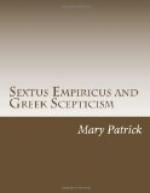THE SEVENTH TROPE.
The seventh Trope is the one which, as we said, is based 129 upon the quantity and constitution of objects, constitution commonly meaning composition. And it is evident that we are obliged to suspend our judgment according to this Trope also in regard to the nature of things. As for example, filings from the horn of the goat appear white when they are seen separately and without being put together; put together, however, in the form of a horn, they look black. And the parts of silver, the filings that is, by themselves appear black, but as a whole appear white; and parts of the Taenarus stone look white when ground, but in the whole stone appear yellow; grains of sand 130 scattered apart from each other appear to be rough, but put together in a heap, they produce a soft feeling; hellebore taken fine and downy, causes choking, but it no longer does so when taken coarse; wine also taken moderately strengthens us, but 131 when taken in excess relaxes the body; food similarly, has a different effect according to the quantity, at least, it often disturbs the body when too much is taken, causing dyspepsia and discharge. We shall be able here also to say of what kind 132 the cutting from the horn is, and what many cuttings put together are, of what kind a filing of silver is, and what many of them put together are, of what kind the tiny Taenarus stone, and what one composed of many small ones is, and in regard to the grains of sand, and the hellebore, and the wine, and




